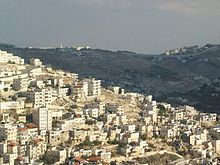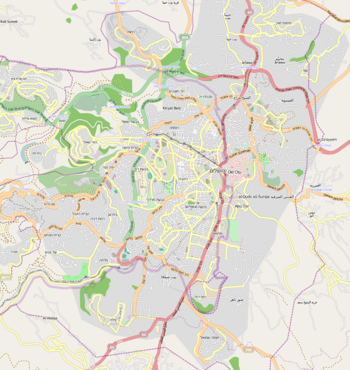Jerusalem
![]()
This article is about the city in the Middle East. For other meanings, see Jerusalem (disambiguation).
Jerusalem (Hebrew ![]() Yerushalayim [jeʁuʃa'layim]; Arabic أورشليم القدس, DMG Ūršalīm al-Quds 'Jerusalem the sanctuary', better known by its short form القدس, DMG al-Quds 'the sanctuary'; Ancient Greek Ἱεροσόλυμα Hierosólyma [n. pl.], or Ἰερουσαλήμ Ierousalḗm [f., indecl.]; Latin Hierosolyma [n. pl. or f. sg.], Hierosolymae [f. pl.], Hierusalem or Jerusalem [n., indecl.]) is a city in the Judean mountains between the Mediterranean Sea and the Dead Sea with a population of about 925,000.
Yerushalayim [jeʁuʃa'layim]; Arabic أورشليم القدس, DMG Ūršalīm al-Quds 'Jerusalem the sanctuary', better known by its short form القدس, DMG al-Quds 'the sanctuary'; Ancient Greek Ἱεροσόλυμα Hierosólyma [n. pl.], or Ἰερουσαλήμ Ierousalḗm [f., indecl.]; Latin Hierosolyma [n. pl. or f. sg.], Hierosolymae [f. pl.], Hierusalem or Jerusalem [n., indecl.]) is a city in the Judean mountains between the Mediterranean Sea and the Dead Sea with a population of about 925,000.
Jerusalem is a meeting place of many cultures, ancient and modern. The Old City is divided into the Jewish, Christian, Armenian and Muslim quarters and is surrounded by a fortification wall dating back to Ottoman times.
The political status of the city is internationally disputed and part of the Middle East conflict. Jerusalem was declared its unified and indivisible capital in 1980 by Israel, which controls the entire city area, through the Jerusalem Law, but recognized as such only by the United States, Guatemala, Honduras, and Nauru. Jerusalem is home to the seat of the president, the Knesset and the Supreme Court as part of Israel's political system, the Hebrew University founded in 1918, and the Yad Vashem Holocaust Memorial and Israel National Cemetery on Mount Herzl. Until the Six-Day War (1967), only West Jerusalem was under Israeli rule; East Jerusalem, which contains important religious sites of Judaism, Christianity, and Islam, is claimed by moderate Palestinian organizations as the capital of a future Palestinian state, while radical Palestinian organizations demand the entire city as its capital.
Name
The city bore various names historically. In Egyptian ostracism texts from the 19th and 18th centuries BC, the letter sequence Ꜣw-šꜢ-m-m first appears as the name of this city. It was probably pronounced (j or u)ruschalimum. In the Amarna letters of the 14th century B.C. ú-ru-sa-lim is attested, and in the Assyrian annals of Sanherib, who besieged the city in the 8th century B.C., ur-sa-li-im-mu. The most common and also oldest form in Hebrew and Aramaic is yrwšlm, jeruschalem, besides a short form yršlm and even shorter šlm, schalem is attested.
The meaning of the name is probably "foundation (yru) of [god] Shalim" or possibly "palace/city (ūru) of Shalim". Shalim was the Canaanite deity of dusk, possibly the patron of the city. The interpretation of the name given by the rabbis, still popular, as "city of peace (šalom)" is a folk etymology. According to it, the short form of the city's name Salem (שלם šhālêm) (Gen 14:18 EU) is said to be related to the Hebrew word shalom (שלום = "peace, salvation"). The Hebrew name Yerushalayim, in common use today, is a ceremonial dual form and did not appear until the Second Temple period. This form was later established by the Masoretes as the biblical reading.
Poetic and religious titles such as the biblical name Zion or Holy City designate Jerusalem as the city of the one, only God whom Jews and Christians worship.
Geography
Location
Jerusalem is situated on the southern spur of a plateau in the Judean Mountains, which include the Mount of Olives to the east and Mount Scopus to the northeast. The Old City is situated at an altitude of about 760 m. Jerusalem is surrounded by numerous dry valleys. The Kidron Valley, to the east of the Old City, lies between the city proper and the Mount of Olives. Along the south side of the Old City is the steeply sloping gorge of Gehinnom, which has been equated with hell in eschatological ideas since biblical times.
Like everywhere else in the Middle East, the water supply in Jerusalem has always been a matter of great expense, as attested by an intricate network of aqueducts (e.g., Qanat as-Sabil), tunnels, ponds (e.g., the Pools of Solomon and the Pool of Siloah), and cisterns that have been found here. Over the course of several millennia, the Gihon Spring in the Kidron Valley at the foot of Jerusalem's Temple Mount remained Jerusalem's main source of fresh water.
Jerusalem is located 60 km east of Tel Aviv and the Mediterranean Sea. To the east of the city, about 35 km away, is the Dead Sea. Other cities and settlements in the vicinity are Bethlehem and Bait Jala in the south, Abu Dis and Maʿale Adummim in the east, and Ramallah and Givʿat Seev in the north.
Climate
| Jerusalem | ||||||||||||||||||||||||||||||||||||||||||||||||
| Climate diagram | ||||||||||||||||||||||||||||||||||||||||||||||||
| ||||||||||||||||||||||||||||||||||||||||||||||||
| Monthly average temperatures and precipitation for Jerusalem
Source: Israel Meteorological Service | ||||||||||||||||||||||||||||||||||||||||||||||||||||||||||||||||||||||||||||||||||||||||||||||||||||||||||||||||||||||||||||||||||||||||||||||||||||||||||||||||||||||||||||||||||||||||||||||||
The Mount of Olives not only protects Jerusalem from the desert wind from the east, but also allows the humid air from the Mediterranean Sea to rain down on the city. In Palestine the westerly winds prevail, in whose windward side the mountainous country lies, whereby the amount of rain increases inland towards the mountains and decreases again over the Jordan valley. Due to this rain shadow effect, the annual precipitation drops from 600 mm in Jerusalem to about 100 mm in the Jordan Valley. In winter the mountainous area cools down and easterly winds towards the warmer Mediterranean become frequent. In summer, the westerly winds also become drier and carry hardly any clouds, but cool and refresh. The sea breeze usually reaches Jerusalem after 2 p.m., having held its own against the dry land, and usually keeps the city pleasantly cool all night (except for a decrease around sunset). When the sea wind does not reach Jerusalem or fails to do so, the nights become hot and lacking in dew and freshness - and when the east wind from the desert also reaches the city, it brings dust and a scorched smell and scorches everything (on about every fifth summer day). Then in the winter this east wind is cold and cutting. In Jerusalem there is a clearly defined rainy season in the winter half-year from about October 14 to May 6, outside of which there is hardly any precipitation - and in summer about 60 cloudless days, which, however, often start out foggy as the heavy early morning dew condenses. In the mountains the spring rains predominate, on the coast the autumn rains, which is why Jerusalem has a relatively cool spring and a fairly warm autumn.
Neighborhood
- Abu Gate
- Old Town
- At-Tur
- Atarot
- Bab a-Zahara
- Baka
- Bayit VeGan
- Beit HaKerem
- En Kerem
- French Hill (also Giv'at Shapira)
- Geula
- Gilo
- Giva Ram
- Givʿat HaMatos
- Har Choma
- Har Nof
- Mea Shearim
- Mishkenot Sha'ananim
- Nof Zion
- Pisgat Ze`ev
- Ramat Eshkol
- Ramat Rachel
- Rechavia
- Sheikh Sharrah
- Silwan
- Talpiot
- East Talpiot
- Umm Tuba
- Yemin Moshe

View of Silwan in East Jerusalem

Jerusalem map
Questions and Answers
Q: What is Jerusalem?
A: Jerusalem is one of the oldest cities in the world that people have continuously lived in. It is important to many major religions, and it is the capital city of both Israel and Palestine under their laws.
Q: Why do Jews consider Jerusalem a holy city?
A: Jews consider Jerusalem a holy city because it was their religious and political center during Biblical times, and it was the place where the Temple of God stood.
Q: Why do Christians consider Jerusalem holy?
A: Christians consider Jerusalem holy because many events in the life of Jesus took place there.
Q: Why do Muslims believe that Muhammad rose to heaven from Jerusalem?
A: Muslims believe that Muhammad rose to heaven from Jerusalem, and Al-Aqsa Mosque is considered to be the first Qibla after Mecca for Muslims.
Q: Where are most embassies located with regards to Israel?
A: Most embassies with Israel are located in Tel Aviv rather than in Jerusalem.
Q: How far away from the Mediterranean Sea is Jerusalem?
A: Jerusalem is about 40 miles (64 kilometers) east of the Mediterranean Sea.
Q: What kind of terrain does Jerusalem have?
A:Jerusalem has hilly terrain with many valleys around it.
Search within the encyclopedia